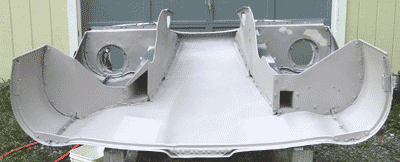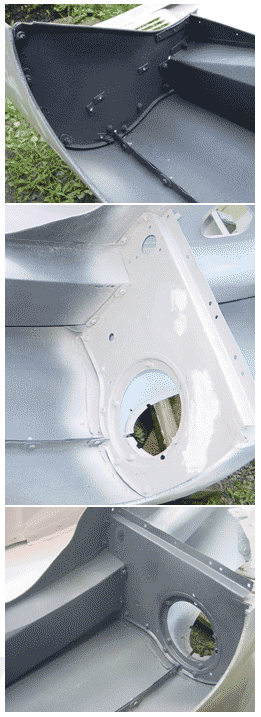Mike Moore, a two-time Jag E-type restorer in California, gave me particulars about getting the Sikaflex adhesive that is "original" for the E-type bonnet.
Mike says it is very good stuff. Nonetheless, I decided to go with a polyurethane adhesive, since I had read in a post from Dan Mooney (of Classic Jaguar) that a good
polyurethane adhesive would do the trick. Besides, I could obtain that nearby.
We glued the flanges to the metal after cleaning up the lines well. The polyurethane adhesive was certainly messy, but it set in about 24 hours. Pictures I had seen of
the glued pieces show that the glue was applied generously and bulges out from the joint. Ours looks pretty standard in that regard. The polyurethane glue we used
is tough stuff after it's dried. Like what I've heard about Sikaflex, it is somewhat flexible, but quite resistant to movement. It is not "rubbery."
North Carolina has periods of summer rains that occur regularly in the afternoon. Since mid July it has been a little wetter than the earlier part of the month (though
 we have really needed the rain). That is to say: moving forth with the bonnet while it's perched (and covered) outside has been a little hit-or-miss. I've
been reluctant to paint when rain threatens, of course. Priming has been a bet with the weather, but by the end of the month the bonnet internals got a coating
we have really needed the rain). That is to say: moving forth with the bonnet while it's perched (and covered) outside has been a little hit-or-miss. I've
been reluctant to paint when rain threatens, of course. Priming has been a bet with the weather, but by the end of the month the bonnet internals got a coating
 of "Tie-Coat" primer and the two-part high-build primer. Also, the front wheel wells were coated with rock guard. Inadvertently, the rock guard ended up a two stage
process, in part because our Internet connection went out after a power outage and I couldn't consult the well illustrated "FAQ" on applying "underseal" that is
posted on Classic Jaguar's web site. The specific page is http://www.classicjaguar.com/schutz.html
— it's a little buried.
of "Tie-Coat" primer and the two-part high-build primer. Also, the front wheel wells were coated with rock guard. Inadvertently, the rock guard ended up a two stage
process, in part because our Internet connection went out after a power outage and I couldn't consult the well illustrated "FAQ" on applying "underseal" that is
posted on Classic Jaguar's web site. The specific page is http://www.classicjaguar.com/schutz.html
— it's a little buried.
Anyway, I initially left the frontmost section of the front well well without rock guard, since I have pictures of a restored Jaguar without
rock guard. I went ahead and smoothed out some ripples on both of these sections, thinking that they were going to be smooth and painted. When RoadRunner came back up, I checked the FAQ
on Classic Jaguar. Sure enough, the front portion also gets rock guard, according to Dan Mooney. The more I though about it, the more I recalled removing rock guard from that
part of the bonnet, too. (I should say that I have learned not to trust anything I found on this car to be particularly reliable as far as originality is concerned.) I went ahead and
applied rock guard to the front section. This was hardly an aggravation. The stuff goes on easily and is an easier cleanup than having to clean up a spray gun. I again used
the "Gravi-Tex" product that I used for undercoating for the IRS well, rear wheel wells, and the underside of the car. It's significantly less expensive than the 3M Rock Schutz.
That pretty much closed the month of July. I was hoping that the car would have color by the end of July, but this is close enough. The rains of the last week or so
didn't cooperate with me. The inside of the bonnet still needs a bit of block sanding (nothing too meticulous, though) and another shot of two-part primer. Then I think
we'll refit it to the car body, and finalize the blocking.
Then ... color! Maybe. I'm now hoping that August is the magical month.
Forgotten Tidbit: Underside Painted Opalescent Dark Green (a while ago — mid-June 2004)
I neglected to mention how I managed to paint the underside of the car. This entailed lifting the car up off the rack and moving the rack back until
the rear section of the car was supported beneath the foremost section of the boot floor, just behind the housing for the IRS. The front of the car —
basically at the point where the frames attach to the body — was supported by a saw horse. This left the entire mid-section of the floor completely
free. And I simply painted it. I wasn't too cramped, since the car was about four feet (a little over a meter) off the ground. (The operation did not lend
itself to photography, I'm afraid.)
Of course, the underside of the car is painted Opalescent Dark Green over the rock guard.
